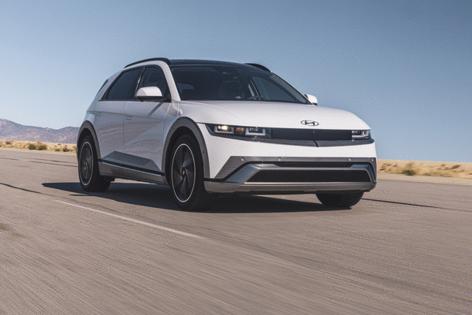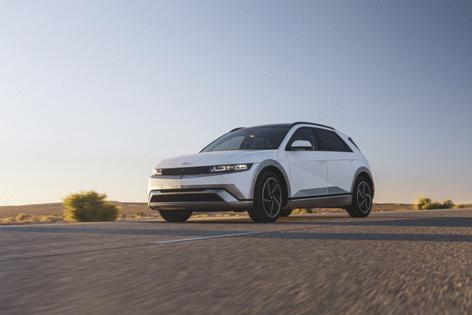Auto review: 2025 Hyundai Ioniq 5 gets a refresh and an off-road model
Published in Automotive News
Electrification has been the key to Hyundai’s 33% retail growth over the past five years, according to Ricky Lao, director of product planning Hyundai Motor America. In fact, sales were up 31% in 2024 compared to the year before. And key to Hyundai’s success is the Hyundai Ioniq 5.
Three years after it first hit the U.S. market, the battery-electric Hyundai Ioniq 5 receives a freshening along with a new off-road model, the XRT, short for Extreme Rugged Terrain. That, along with some notable changes, make the Ioniq 5 an even more attractive EV for 2025.
The 2025 Hyundai Ioniq 5 will be built in Hyundai’s Metaplant near Savannah, Georgia, making it eligible for a federal EV tax credit, should it survive. The Ioniq 5 hasn’t been eligible in the past, but Hyundai officials have been making up for it with financial incentives to ensure its competitors that are eligible don’t have an unfair price advantage.
Regardless, there are driveline upgrades for the new model year.
Rear-wheel drive models get a solitary electric motor driving the rear axle and producing 168 horsepower and 258 pound-feet of torque. All-wheel-drive trims have an additional motor on the front axle that brings output up to a far more substantial 320 horsepower and 446 pound-feet of torque. Rear-wheel drive is offered on models. All-wheel drive is offered on all trims except the SE Standard Range and is standard on the XRT.
The Ioniq 5’s batteries have increased capacity as well, allowing for greater range than before. Rear-wheel drive SE Standard Range models now have 245 miles of range, with SE, SEL and Limited models having 318 miles of range. All-wheel drive SE, SEL models provide 290 miles of range, while Limited models travel 269 miles, with XRTs providing 259 miles. Towing is not recommended.
All 2025 Hyundai Ioniq 5 models come with Tesla's North American Charging Standard (NACS) port, meaning that owners can recharge their vehicle at 17,000+ chargers on Tesla’s Supercharger network nationwide. Hyundai also provides a Combined Charging System (CCS) adapter for non-Tesla charging stations. This makes long-distance travel a little less harrowing. And Hyundai is partnering with eight other automakers in establishing the Ionna charging network, which is slated to have 30,000 charging stations by 2030.
Recharging from 10 percent to 100 percent requires seven hours and 20 minutes, while recharging on a 250 kWh DC fast charger from 10 percent to 80 percent requires 20 minutes.
Inside, you’ll find redesigned HVAC controls, a center console with physical heated front seat controls, a fresh steering wheel design and heated rear seats on all trims except SE models. There's also a new 12.3-inch infotainment screen with wireless Apple CarPlay and Android Auto integration, over-the air updates and USB-C ports.
All models receive a front and rear facelift, while the rear window has a wiper for the first time. The new XRT model gets further differentiation with digitized camo trim, black body trim, improved approach and departure angles, addition inch of ground clearance, 18-inch wheels with all-terrain tires, Bose Premium audio system, surround view monitor and blind-spot view monitor and unique suspension tuning.
What hasn’t changed is the Ioniq 5’s oversized hot hatch look, seeming every bit as fresh as the day it was released.
In an automotive market filled with undersized, overtaxed turbocharged four-cylinder petrol engines, the 2025 Hyundai Ioniq 5 offers up its power immediately. Power delivery is very linear, providing a strong, smooth surge of muscle. With four levels of driver-selectable brake regeneration, this is a very easy car to drive smoothly, particularly with one pedal. More impressively, there’s actually some feedback through the steering wheel. You might be tempted to call it a hot hatch, as it furnishes strong power on a well-engineered chassis that delivers a truly entertaining driving experience. Body lean comes on gradually though corners, it leans modestly but is not extreme. In fact, there’s nothing in this driveline that’s extreme, being remarkably refined overall.
And, as you’d expect from an EV, it’s incredibly quiet.
Heading off-road reveals this vehicle to have surprising chops once the sidewalk ends.
We inadvertently took a street model off-road, and while it handled the dirt road – its gravel, rocks and dips – with alacrity, the firm suspension made for a somewhat punishing ride. In comparison, the XRT’s suspension provided far more compliance, making it more of a natural off-road warrior while providing a very comfortable ride. It also more clearly telegraphed when the back end was sliding, making it easier to control. If you are doing any amount of off-road work, the XRT is the trim to choose.
What’s clear is the 2025 Hyundai’s updated Ioniq 5 remains a competitive, spacious, fun-to-drive EV that’s a must-drive for those considering a petrol-free future.
2025 Hyundai Ioniq 5
Base price: $42,500-$58,100
Engine: Permanent-magnet synchronous motor
Horsepower/torque: 320/446 pound-feet
EPA-estimated range: 290 miles
Recharge time (10-100%): 7 hours, 22 minutes (240V)
Length/Width/Height: 183/74/63 inches
Ground clearance: 6 inches
Payload: 1,025 pounds
Cargo capacity: 26-59 cubic feet; 0.85 cubic-foot frunk
Towing capacity: Not recommended
©2025 Tribune Content Agency, LLC











Comments